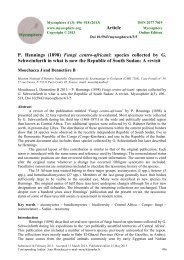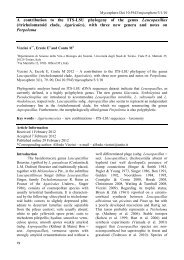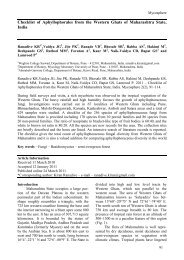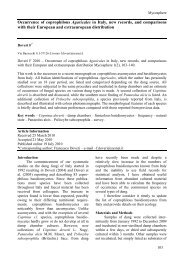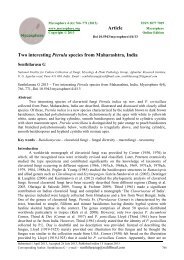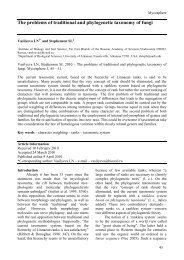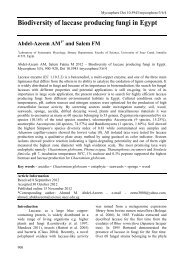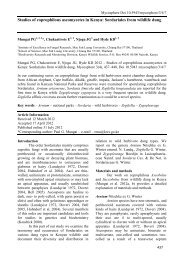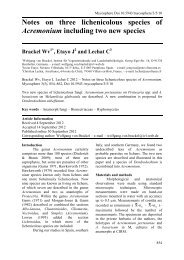Checklist of Aphyllophorales from the Western Ghats of Maharashtra ...
Checklist of Aphyllophorales from the Western Ghats of Maharashtra ...
Checklist of Aphyllophorales from the Western Ghats of Maharashtra ...
Create successful ePaper yourself
Turn your PDF publications into a flip-book with our unique Google optimized e-Paper software.
Fig. 1 – Map <strong>of</strong> India showing <strong>Maharashtra</strong><br />
State.<br />
in semi-evergreen pockets while o<strong>the</strong>rs have<br />
migrated towards South India. The temperate<br />
species have migrated to higher altitudes.<br />
Many species disappear <strong>from</strong> <strong>the</strong> <strong>Western</strong><br />
<strong>Ghats</strong> due to uncertainty <strong>of</strong> rainfall and rise in<br />
temperature (Mahabale 1987). Meherhomji<br />
(1977) considered that <strong>the</strong> deciduous vegetation<br />
is <strong>of</strong> degenerate type.<br />
The forest in <strong>Maharashtra</strong> State occupies<br />
66,725 square kilometres, which is over 21.7 %<br />
<strong>of</strong> <strong>the</strong> area <strong>of</strong> India under forest. The forested<br />
areas in <strong>the</strong> state are distributed in three zones:<br />
western, nor<strong>the</strong>rn and eastern. The western<br />
zone includes <strong>Western</strong> <strong>Ghats</strong> and its foothills;<br />
<strong>the</strong> nor<strong>the</strong>rn zone comprises <strong>the</strong> Satpuras and<br />
<strong>the</strong> Melghat, and <strong>the</strong> eastern zone corresponds<br />
with Ramtek upland, Chiroli hills, Ahiri upland,<br />
Dewalmari hills and Nawegaon hills. No part<br />
<strong>of</strong> <strong>Maharashtra</strong> has a rainfall <strong>of</strong> less than 1000<br />
mm (Dikshit 1989). Ecologically several types<br />
<strong>of</strong> forests can be identified in <strong>Maharashtra</strong> by<br />
taking into consideration <strong>the</strong> amount <strong>of</strong> rainfall<br />
and soil moisture in an area and <strong>the</strong> morphological<br />
characteristics <strong>of</strong> <strong>the</strong> member trees.<br />
The forests <strong>of</strong> <strong>Maharashtra</strong> can be placed in at<br />
least five categories: tropical evergreen hill<br />
forest, tropical moist deciduous forest, tropical<br />
dry deciduous forest, tropical thorn forest, and<br />
littoral and swamp forest.<br />
92<br />
Study <strong>of</strong> <strong>Aphyllophorales</strong> in India<br />
Studies on <strong>Aphyllophorales</strong> were initiated<br />
along with <strong>the</strong> launch <strong>of</strong> studies on Indian<br />
fungi. The first Indian record <strong>of</strong> a member <strong>of</strong><br />
<strong>the</strong> <strong>Aphyllophorales</strong> can be traced to Koltzsch<br />
(1832) in his paper on Indian Polyporaceae.<br />
Later Berkeley (1839) described a few Indian<br />
polypores which were collected by W.J.<br />
Hooker. During <strong>the</strong> first quarter <strong>of</strong> <strong>the</strong> 20 th<br />
century, Massee (1901, 1906, 1908, 1910)<br />
published several accounts <strong>of</strong> Indian fungi<br />
based on collections sent to Kew Herbarium by<br />
several workers, notably by Sir E.J. Butler<br />
(1905a,b,c,d, 1918). Several Indian <strong>Aphyllophorales</strong><br />
were also reported by Lloyd (1898–<br />
1925) and Sydow et al. (1906, 1907, 1911,<br />
1912, 1916). Theissen (1913a,b) reported many<br />
poroid <strong>Aphyllophorales</strong> collected <strong>from</strong> <strong>the</strong><br />
Bombay presidency by Blatter. S.R. Bose<br />
(1919, 1923, 1924, 1925, 1927) was <strong>the</strong> first<br />
Indian mycologist to provide a comprehensive<br />
account <strong>of</strong> <strong>the</strong> Indian polypores which he<br />
collected <strong>from</strong> Bengal and its surroundings.<br />
Sundaramani & Madurajan (1925) reported<br />
several members <strong>of</strong> Polyporaceae <strong>from</strong> Madras,<br />
and by 1925 <strong>the</strong>re were more than 300 reports<br />
on <strong>the</strong> <strong>Aphyllophorales</strong> (Fig. 2).<br />
Butler & Bisby (1931) made a compilation<br />
<strong>of</strong> <strong>the</strong> Indian fungi in <strong>the</strong>ir classic work<br />
“The Fungi <strong>of</strong> India”. This important work<br />
stimulated <strong>the</strong> study <strong>of</strong> Indian fungi including<br />
<strong>Aphyllophorales</strong>. Our knowledge about <strong>the</strong><br />
Indian <strong>Aphyllophorales</strong> was increased by <strong>the</strong><br />
contributions <strong>of</strong> Bagchee & Bakshi (1950)<br />
Bagchee et al. (1954), Bakshi (1958, 1971),<br />
Bakshi et al. (1963), Puri (1956), Ramakrishan<br />
(1959), Rehill & Bashi (1965), Welden (1965),<br />
Reeves et al. (1967), Thind (1973, 1975), Sa<strong>the</strong><br />
& Rahalker (1977), Rattan (1977), Thind &<br />
Dhanda (1978a,b), Anjali Roy (1979, 1981a,b,<br />
1982, 1983, 1984, 1987), Harsh (1982),<br />
Natarajan & Raman (1980), Natarajan &<br />
Kolandavelu (1985),Vaidya (1987) Vaidya &<br />
Bhor (1990) Vaidya et al. (1991), Vaidya &<br />
Rabba (1993a,b), Rabba (1994), Sharma (1995)<br />
and Nanda (1996). Leelavathy & Ganesh (2000)<br />
published details <strong>of</strong> 80 species <strong>of</strong> polypores<br />
belonging to 32 genera <strong>from</strong> three families<br />
(Ganodermataceae, Hymenochaetaceae and<br />
Polyporaceae) in <strong>the</strong> book “Polypores <strong>of</strong><br />
Kerala”.



